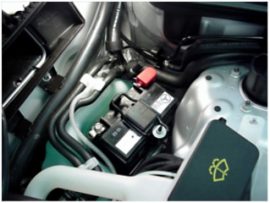Professionals to DIY
We're Online 9am - 5pm
On Orders Over £30
Auxiliary & Back-up Automotive Batteries Explained
Auxiliary Battery Overview
Modern vehicles with CO2 reduction technologies, high levels of specification, and new electronic driver aids may feature an auxiliary battery alongside the main vehicle starter battery or high voltage system battery on Hybrid and electric vehicles. Auxiliary batteries vary in size and specification dependent on the demands placed on it by the vehicle electrical system and can be used as a safety back-up to support the main battery when required or to provide voltage for specific vehicle systems all of the time.
IC Dual Battery Systems
The dual battery system isolates all power supply sensitive electrical components which may be affected by low voltage from the primary battery during the engine starting phase.
Two contact switches are used to change the power supply into two separate circuits when an engine start is required.
Electrical power is then supplied to the sensitive electrical components from the secondary battery when an engine start is in progress.
The primary battery supplies power to the starter motor and maintains essential power to the Engine Management System (EMS) which is essential for engine starting.
Primary and secondary battery voltages are monitored to ensure sufficient voltage is available for the next start event and charge can be supplied to the secondary battery when required.
IC Dual Battery System Components
System components:
1. Starter motor
2. Primary battery
3. Power & EMS loads
4. Field effect transistor
5. Contact switch 1
6. Contact switch 2
7. Secondary battery
8. Sensitive loads
9. Alternator
IC Dual Battery System Operation
System Conditions – Start Required
• Contact 1 open
• Contact 2 closed
The primary battey supplies the starter motor and the secondary battery supports power supply sensitive components
System Conditions – Engine Running
• Contact 1 closed
• Contact 2 open
The primary battery is being charged by the alternator and the secondary battery is isolated from the circuit.
If the system detects a low auxiliary battery voltage contact 2 will remain closed once the engine is running to enable the auxiliary battery to be fully charged by the alternator.
Once the auxiliary battery is fully charged contact 2 will open to prevent damage to the axuiliary battery and reduce alternator and consequently engine loads to save fuel and reduce emissions.
Hybrid Vehicle Auxiliary Battery
 Most Hybrid vehicles such as the Toyota Prius feature a conventional 12 Volt auxiliary battery in addition to the high voltage hybrid system battery.
Most Hybrid vehicles such as the Toyota Prius feature a conventional 12 Volt auxiliary battery in addition to the high voltage hybrid system battery.
The 12 Volt battery is not used for engine starting or to power the traction motors but is used to supply power to:
- Accessory systems
- Headlights
- Audio systems
- Computer controls
Electric Vehicle Auxiliary Battery
 Electric vehicles such as the Mitsubishi i-miev feature a conventional 12 Volt auxiliary battery in addition to the high voltage traction battery.
Electric vehicles such as the Mitsubishi i-miev feature a conventional 12 Volt auxiliary battery in addition to the high voltage traction battery.
The auxiliary battery is not used by the traction motor but is charged by the traction battery and is used to support all of the electrical systems on the vehicle with the exception of:
- Air conditioning
- Heating system
Click Here to purchase Yuasa Auxiliary Batteries - Yuasa Auxiliary Batteries
AGM vs. EFB Car Batteries: Choosing the Right Power Source | Blog

Introduction: Car batteries are the heartbeat of your vehicle, providing the necessary power to start the engine and operate various electrical components. As automotive technology advances, so do the types of batteries available on the market. Among the newer options are Absorbent Glass Mat (AGM) and Enhanced Flooded Battery (EFB) technologies, designed to offer improved performance and reliability. In this blog post, we'll delve into the differences between AGM and EFB car batteries to help you make an informed decision when choosing the right power source for your vehicle.
What are AGM and EFB Batteries? AGM and EFB batteries are both types of lead-acid batteries, commonly used in modern vehicles, especially those equipped with start-stop systems and other advanced electrical features. While they share some similarities, such as their basic composition and function, there are distinct differences in their design and performance characteristics.
Absorbent Glass Mat (AGM) Batteries: AGM batteries are constructed with a unique design that incorporates absorbent glass mats sandwiched between the battery's plates. These mats are saturated with electrolyte, allowing for better retention and distribution of the acid solution. This design feature enhances the battery's durability and resistance to vibration, making AGM batteries ideal for vehicles with demanding electrical requirements.
Key Features of AGM Batteries:
- Enhanced Durability: AGM batteries are highly resistant to vibration and shock, making them suitable for rough driving conditions.
- Maintenance-Free: Unlike traditional flooded batteries, AGM batteries are sealed, eliminating the need for electrolyte maintenance.
- Faster Recharge: AGM batteries have lower internal resistance, allowing for quicker charging and higher output currents.
- Deep Cycle Capabilities: AGM batteries can withstand deeper discharges without suffering damage, making them suitable for vehicles with frequent start-stop cycles.
Choosing the Right Battery for Your Vehicle: When selecting a battery for your vehicle, it's essential to consider your specific driving habits, vehicle requirements, and budget constraints. Here are some factors to keep in mind:
- Vehicle Compatibility: Consult your vehicle manufacturer's recommendations to determine whether AGM or EFB batteries are compatible with your vehicle's electrical system.
- Performance Requirements: If your vehicle features advanced electrical systems or frequently undergoes start-stop operation, AGM batteries may offer superior performance and longevity.
- Budget Considerations: While AGM batteries typically command a higher price point than EFB batteries, they may provide better long-term value due to their durability and maintenance-free operation.
- Environmental Conditions: Consider factors such as temperature extremes and driving conditions when selecting a battery type, as these factors can impact battery performance and lifespan.
Mastering Car Wheel Components: A Comprehensive Guide to Wheel Bearing Kits, Wheel Hubs, and Wheel Nut Sets
Introduction: Your car's wheels are more than just round rubber and metal. They rely on a complex interplay of components to ensure smooth and safe operation on the road. Among these crucial parts are wheel bearing kits, wheel hubs, and wheel nut sets. In this in-depth guide, we'll explore these essential components, their functions, importance, and maintenance tips to enhance your understanding and help you optimise your vehicle's performance.
Understanding Wheel Bearing Kits: Wheel bearing kits consist of bearings, seals, and sometimes hubs, designed to support the wheel's rotation and maintain its alignment. Here's what you need to know:
- Function: Wheel bearings enable smooth wheel rotation by reducing friction between the wheel hub and spindle.
- Importance: Properly functioning wheel bearings are essential for safe driving, as worn bearings can lead to wheel wobble, vibration, and compromised vehicle handling.
- Maintenance: Regular inspection and replacement of worn or damaged wheel bearings are vital to ensure optimal vehicle performance and safety.
Exploring Wheel Hubs: Wheel hubs are the central component of the wheel assembly, connecting the wheel to the vehicle's suspension system. Here's why they matter:
- Function: Wheel hubs provide a mounting point for the wheel, allowing it to rotate freely while supporting the vehicle's weight.
- Importance: Intact wheel hubs are crucial for maintaining wheel alignment, stability, and proper functioning of the braking system.
- Maintenance: Periodic inspection and maintenance of wheel hubs, including checking for signs of wear, play, or damage, are essential to prevent potential issues and ensure safe driving.
Delving into Wheel Nut Sets: Wheel nut sets secure the wheel to the hub, ensuring proper alignment and preventing wheel detachment. Here's what you should know:
- Function: Wheel nuts, along with wheel bolts or studs, fasten the wheel to the hub, providing a secure connection.
- Importance: Properly tightened wheel nuts are critical for preventing wheel loosening or detachment while driving, which can lead to accidents or damage.
- Maintenance: Regular inspection of wheel nut torque and condition, as well as replacement of worn or damaged nuts, is essential to maintain wheel security and safety.
Importance of Maintenance: Regular inspection and maintenance of wheel bearing kits, wheel hubs, and wheel nut sets are crucial for vehicle safety and performance. Adhering to manufacturer recommendations and promptly addressing any signs of wear, damage, or looseness can prevent costly repairs and ensure a smooth and safe driving experience.
Conclusion: Car wheel components, including wheel bearing kits, wheel hubs, and wheel nut sets, are integral to your vehicle's performance and safety on the road. By understanding their functions, importance, and maintenance requirements, you can ensure optimal operation and longevity of your vehicle's wheels. Regular inspection, proper maintenance, and timely replacement of worn or damaged components are essential practices to enhance vehicle safety and driving experience.
Click here to purchase Car Wheel Bearing Kits, Wheel Hubs and Wheel Nuts & Bolts from YMF Car Parts - Wheel Bearing Kits & Wheel Hubs
Demystifying Car Alternators and Starter Motors: Your Comprehensive Guide
IMTFA Annual Awards Dinner 2023

Back in September 2022 The IMTFA (IFA) buying group www.IMTFA.co.uk (which YMF is a long standing member of) held a group member meeting at The Eden Project down in Bodelva, Cornwall.
Whilst they were there, a young man named Henry Taylor (Son of Gretal Taylor who runs the IFA Head Office in Truro, Cornwall) gave a brilliant speech to the IFA members asking for sponsorship for him and his mum to walk the Cornish Coastal Path as he was looking to raise £4,000 in total for a World Scout Jamboree in South Korea.
He impressed the IFA members so much that they collectively decided to donate the full £4,000 that he was asking for which was a huge shock to Henry and he was over the moon with the news.
Henry was later selected as 1 of only 36 people from Cornwall to attend the 25th World Scout Jamboree in South Korea.
Whilst that is a very nice heartwarming story, it doesn’t quite end there……
Fast forward to November 2023 - The IMTFA (IFA) Buying group held their annual awards dinner which took place on the Riverside Mozart Ship as it embarked on a luxury cruise down the river Danube.
The event was attended by IMTFA Members and Key Supplier and Henry was in attendance with his mum.
He was also sporting a beautiful mullet haircut which drew a lot of attention in the days that followed.
On the second evening, a Gala Dinner Dance was held, and Henry gave a speech thanking the members for their sponsorship 12 month’s prior and shared some of his experiences from his trip to South Korea with the 160x attendees.
This received a huge round of applause from the room and showcased the now famous mullet to the entire audience.
As part of the annual awards dinner, a charity auction and raffle are held, and this year’s was pretty special.
After the usual auction prizes had been bid and won (generating £15,000 for the homeless charity Shelter) a second bidding war erupted which would end up raising £68,500 for Great Ormand Street Childrens Hospital.
We will leave Henry to tell the story in his own words below from a report that his school teacher asked him to write which tells the story of the “Million Dollar Mullet”




